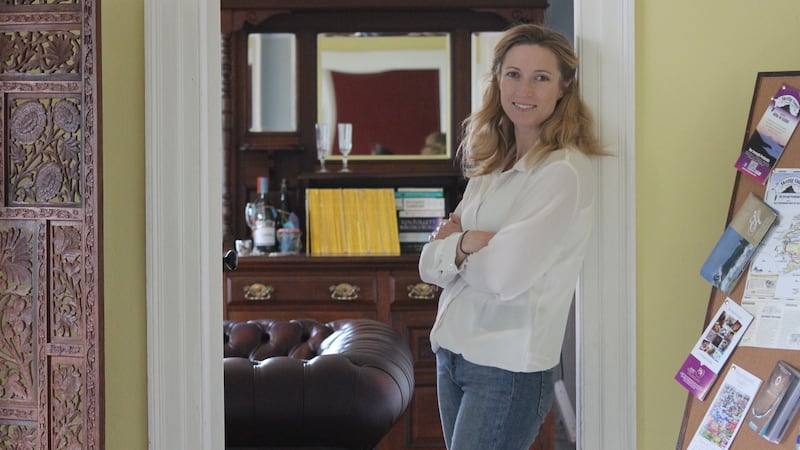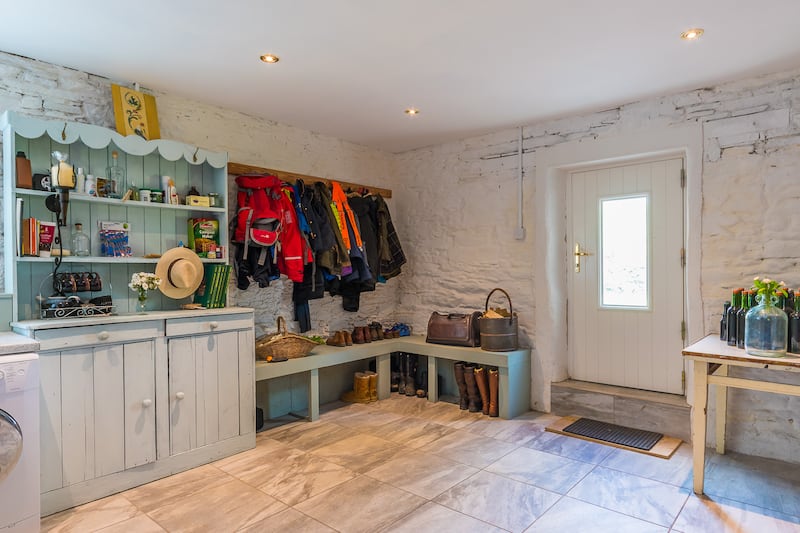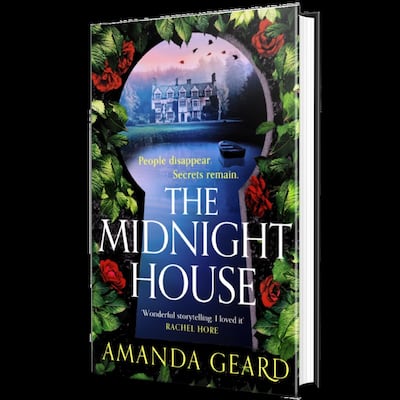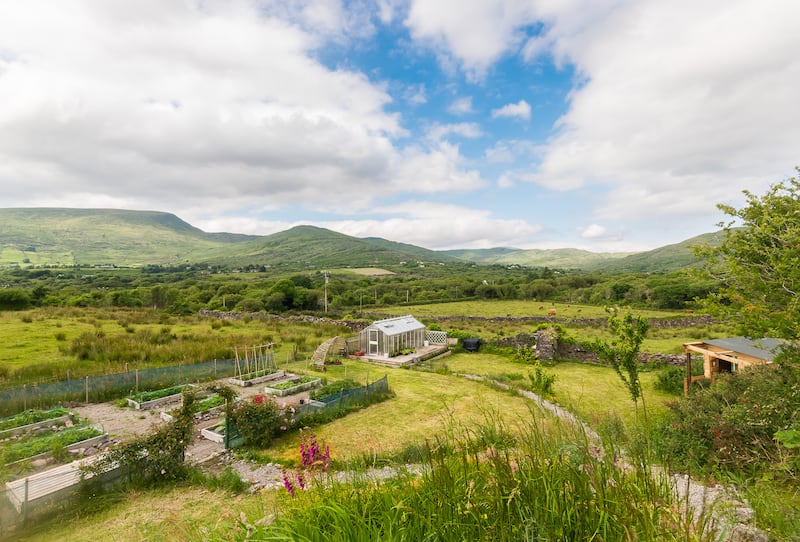On Christmas Eve almost a decade ago, Tasmanian geologist and novelist Amanda Geard and her British husband closed on the purchase of an abandoned Georgian house in the wilds of Kerry. And despite the derelict condition of their new home, they moved straight in, pitching a tent on the bare floorboards of an upstairs room, where the “sea-scented wind” whistled through the windows.
“The electricity was still connected, so we put in a bulb, switched on a light, and it must have been a beacon, because visitors soon followed, bearing homemade plum cake, whiskey and questions,” Geard recalls.
“We lit a fire in the only open chimney, which drew a little of the smoke away, and woke on Christmas morning with condensation on our faces. There was no kitchen… but we plugged in a slow cooker and made an ad hoc Christmas dinner with not-quite-all the trimmings. We didn’t need to chill the bubbly because the temperature downstairs was four degrees!” she says.
“We bought the last couple of strings of tinsel from the local shop, hung them over the windows, and toasted our new adventure in a place where we knew no one, and a huge renovation task lay before us,” she says. “Six days later, we were celebrating New Year’s at the local pub, linking arms with new friends, and belting out a rendition of Auld Lang Syne, as though we weren’t blow-ins at all.”
Christmas in Kerry was quite a contrast to the festive celebrations Geard grew up with in the Australian island state of Tasmania. “There it’s all sunburned days, beach cricket, and crayfish cooked on the barbecue.” It’s a place where Santa wears red board shorts and a traditional Akubra hat.
“I try to get back every couple of Christmases,” she says. “It’s a wonderful chance to visit relatives who are unable to come to Ireland. And actually, they love hearing tales of Irish Christmas, and always ask, every year: ‘But is there snow?’”
So, how did two globe-trotting geologists end up putting down roots in Kerry? For years, the couple had embraced a nomadic lifestyle, living everywhere from a houseboat in London to a Norwegian island as they sought out rocks and adventure. “The work was so demanding and nomadic that we hadn’t, for an age, had anywhere to hang our hats.”
But a serendipitous holiday in Kerry in the autumn of 2014 changed everything. “We rented a sort of go-kart of a hire car, the cheapest thing you could get,” she remembers with a laugh. “We were bumbling round the Ring of Kerry. We came round a corner in south Kerry near Castlecove and saw this derelict house.”

The period house, though abandoned, had a real presence to it. And there was a “For Sale” sign hanging on the gate. “I always remember, the sign was leaning. The letters almost seemed to be dripping,” she recalls. Intrigued, they called the number on the sign. “The next day we found ourselves with the keys in hand, looking around the house.”
The property was one of the original big Georgian houses of Kerry, built in the 1820s. In the late 1800s, a local family bought it and lived in it for generations until it became too hard for them to maintain. In the 1970s, it passed into another set of hands and the new owners started renovations but put it up for sale at the end of the Celtic Tiger era. It remained unsold and empty until Amanda and her husband happened upon it.
After the viewing, they decided to take the plunge and make it their base while still working as geologists. “In the years to follow, we renovated room after room… waking it from a decades-long slumber, filling it with more family and friends as the seasons rolled round.”
In the course of the extensive renovations, they unearthed some lovely stories. In the attic, they found a “really amazing piece of timber” with the following words written upon it: “When this comes down, pray for me.” It was dated 1911, and was signed by someone called Tim O’Shea. “It was just amazing to find that. And actually our neighbours found the family and returned the piece of timber to them.”
A neighbour who used to live in their house would often come over and fill them in on its history. “She was born in the house, her kids were born in the house, her mother was born in the house. She would take us room to room and tell us what used to happen,” she says. “You couldn’t imagine a better neighbour.”
The woman pointed out some new plaster and said there had once been a window there that she used to sit at and look over the back fields to check the cattle, so they decided to excavate the opening and put a window back in. And in the garden, there had been seven apple trees, one for each of the children of the family. “Only one gnarled tree remained when we arrived. It must have been about six decades old,” Geard says. They brought the tree back to life, and planted another seven to make an orchard.
There’s a great mixture of sadness and pride when we drive past the old place, but also joy to see it so loved by the new owners
With warm and supportive neighbours like this, they immediately felt accepted into the community. They’ve made many friends over the years and Geard even has a godchild down the road now. “We’ve all been through a lot together in 10 years.”
She says the most amazing thing about living in their little corner of Kerry is that if she has a rough day at the (home) office, all she has to do is go down to the local Mace. “Someone in there will say something to make you smile and lift your day and I really love that and value that. It sounds a bit saccharine but it’s so true. There’s always someone to lift your mood.”


Not only did the move to Kerry bring a sense of community, but it also sparked Geard’s career as a novelist. She had written stories as a child and always loved reading, but was busy with her life as a geologist. “It wasn’t till we’d been in Kerry for a while and some of the bigger jobs of the renovation had passed that I pulled out a notebook and started jotting down ideas,” she says. “And then it was really a trip to Listowel Writers’ Week in 2019 that was a catalyst for me.”
She was at one of the literary festival events and an audience member put up her hand and said she’d had interest from an agent in her manuscript. “I looked at her. She looked as normal as me. I was so impressed. It really inspired me. That night I went home and pulled off books from my bookshelf, books that I loved and genres that I’d like to write in and began writing down ideas. It was amazing.”

She went on to write her debut The Midnight House, which was chosen as a Richard and Judy Book Club pick, and she says the prologue of the novel was very much inspired by her house.
Her second novel The Moon Gate is set in Kerry, London and Tasmania. “Hopefully readers in Ireland will also get to know Tasmania,” she says. “There are a lot of similarities in the people and the laid-back nature.”
For both novels, she created a fictional town called Ballinn, taking all the things she loves about Kenmare, Sneem and Waterville and merging them into one. “When it comes to nature [in the books], the inspiration is taken directly from the land around me.”
She’s now managing to combine her two careers as geologist and novelist. “I’m travelling a lot less and able to do a lot more from home since Covid. The writing is creeping more and more into my day,” she says. “The two combine quite well together and I’m always travelling in my mind, whether following the rocks or following the words.”
As for the big house, in the end it turned out to be a massive job to heat and maintain. They tried Airbnb after the renovation, but soon decided they missed having a project to work on. Then, an interesting property came up in the next parish, with a little forest to manage as well, “just to throw in another angle”, and the couple jumped at the chance for a new challenge.
“There’s a great mixture of sadness and pride when we drive past the old place, but also joy to see it so loved by the new owners.”

So, Geard and her husband moved down the road to a renovation project of a different kind – a classic 1970s bungalow built on the site of the old local school. Although there’s very little left of the original schoolhouse, the chestnut trees that would have surrounded it still stand. When Geard looks out from her new writing room, she sees “all green”, as it has a view of the beautiful old trees and a big garden with ivy-covered walls.
So does Kerry feel like home now? “Yeah it does, I’m so happy here. The idea that we could have settled somewhere is surprising really. We had been nomadic for so many years. There must be a really special pull here in Kerry.”
And though they’ve been there nearly a decade and soldiered through two renovations, that original Christmas holds a very special place in their memory. “We never forgot that first year, the tent on the bare floorboards, wind rattling the windows, our frosty breath clouding the frozen air... and Auld Lang Syne in the arms of new friends that have now become old friends.”
Amanda Geard’s second novel The Moon Gate is published by Headline Review
















